From The Tennessean in Nashville, Tennessee. February 1999.




Article by Angela Wibking in the Nashville Scene _ 03-15-99
Old friends, old clothes, and old buildings are the inspirations for Peggy Snow's latest oil paintings, now on view at Vanderbilt University. The Nashville artist caught the attention of the local media last month, when she spent over three weeks on West End Avenue battling the elements and curious onlookers to paint a portrait of the Jacksonian as the old building was reduced to rubble.
Actually, Snow created three portraits of the building. The one Snow calls "The Wasteland" is a large oil painting in which the structure almost overflows the picture frame in splashes of gold and black. Another view of the dying Jacksonian highlights a huge red wrecking crane and ball as it descends upon the building. Snow's third view includes the Westboro, another vintage apartment complex, in the background; a wrecking ball looms over the building, as if to suggest the Walgreen-ing of West End has only just begun.
While all three works are included in the Vanderbilt show, human faces rather than architectural facades form the heart of the exhibit. The show features 10 portraits of Snow's female friends and relatives wearing favorite old or vintage clothes. "I've always worn old dresses," Snow says. "So do a lot of my friends. One day a friend was wearing an old pink lace dress that was really exquisite, and I got the idea for the show. Painting these portraits has been so much fun, because when my friends came over to sit for their portraits it was sort of like playing dress-up again."
Snow's subjects include her teenage niece Rachel, shown sitting casually on the floor holding a hand of cards. A long scarf belonging to an aunt is knotted loosely around the young girl's neck, and she wears a sleeveless white top and a flowing pair of slacks belonging to her grandmother. As in all of Snow's work, the artist uses rich, intense colors in unexpected combinations and a swirling brush-stroke style. It is obvious in both Snow's color choices and her brushwork that German Expressionism and the works of post-Impressionist Vincent Van Gogh have been strong influences; indeed, Snow mentions both as her favorites.
The artist holds a degree in art and English from Belmont University and speaks fluent German. She received a one-year scholarship to pursue her master's degree in painting at the University of Montana but left without completing her degree. While she loved the Big Sky country of Missoula, Mont., she found the academic art world demoralizing. "Criticism seemed to be the name of the game, and I got so little encouragement," she recalls.
Returning to Nashville, Snow decided to follow her own path as a painter. Her work has been exhibited at local galleries, including James-Ben Gallery in Franklin, and at the High Museum in Atlanta. The Tennessee State Museum also owns one of Snow's paintings. Snow understands that her style isn't very commercial or trendy, and she admits she's had little success selling her work through galleries. To supplement her income from direct sales and the occasional commission, the artist also works as a substitute English and German teacher in area schools.
Though it's not exactly a wage-earning endeavor, Snow also sings and plays guitar in a folk-rock group called the Cherry Blossoms. Fittingly enough, several of her portrait subjects are fellow musicians. In Snow's portrait of her friend Ann, the musician and visual artist is shown strumming an autoharp and wearing a bright-green velvet tunic that accentuates her long red hair. Another friend named Mallory, who sings with the Cherry Blossoms, is depicted in a full-length portrait wearing her mother's blue prom dress. At her feet is her dog Charley, wearing the white fur coat passed down to him by his elders.
Two friends named Emily are also captured on canvas. One wears a vintage green sweater, accessorized with her grandmother's bead necklace and earrings. The other Emily shows off a feathered hat belonging to her grandmother. Friend Anna dons a Bavarian-style costume decorated with rickrack, while Laurel models a print polyester dress of the type that was a wardrobe staple 40 years ago. But the portrait that takes the show's title most literally, perhaps, is one of 10-year-old Eva Marie, all dressed up in an adult-sized black evening dress of her grandmother's.
Then there's Snow's self-portrait called "Buttons for Buttons' Sake," which shows the artist in a 1940s red dress belonging to her mother and a purple pillbox hat of her grandmother's. The buttons of the title adorn the neckline and the waist but don't serve a practical purpose. "Like the brick and stonework you see in old buildings, the buttons are just there for beauty's sake," Snow says.
In the self-portrait, Snow holds a paintbrush in her hand, and she is pictured at work on a canvas just outside the picture frame. Behind her are the weathered boards and windows of an old house, a reference to the artist's preference for painting on site rather than from photographs in a studio.
"I love painting outdoors," Snow says in her artist's statement. "Dust, insects, and leaves find their way into the paint and leave their imprint. The wind blows off boards, and scavengers of brick come to deliver a building's deathblows. There is all manner of conversation and interaction with people living, working, or passing by, and thus I become informed about what I am painting." It is that kind of interaction, which Snow experienced so fully while painting the Jacksonian, that the artist says puts her work in the realm of performance art.
In many ways, Snow's portraits of old friends in old clothes send the same message as her portraits of old buildings. They remind us that crumbling brick, worn wood, and hand-me-down garments can connect us to our past and to each other. If we lose that connection, Snow's paintings seem to say, we lose our very sense of identity.
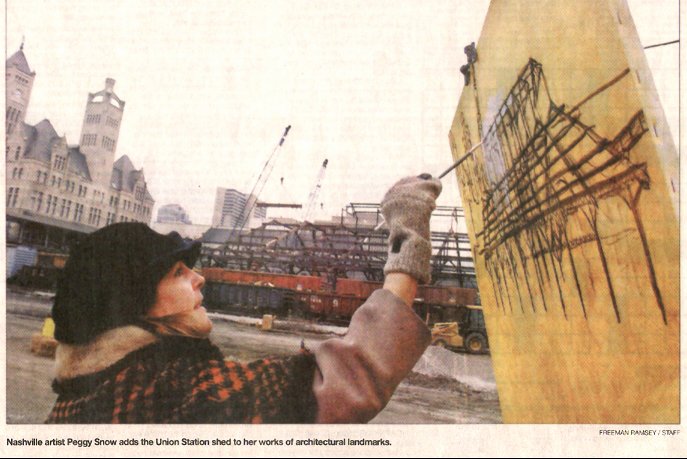
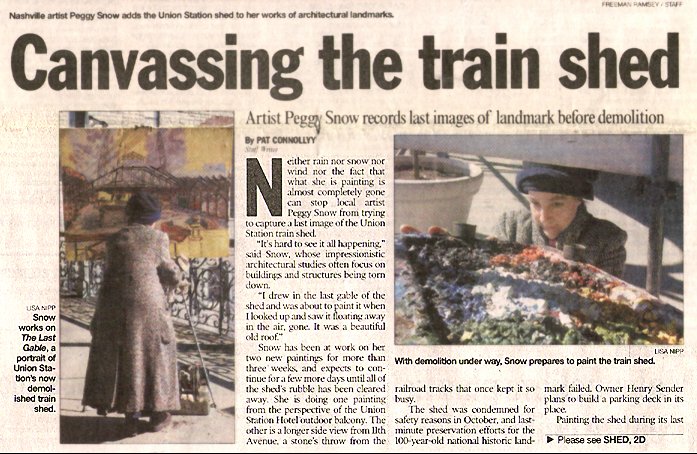
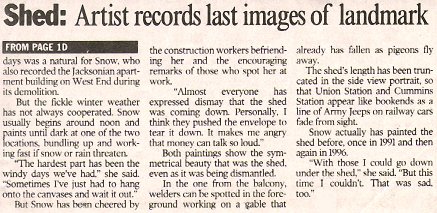
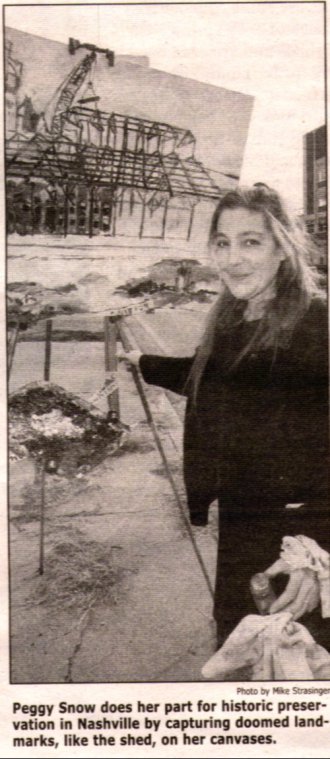 |
Peggy Snow stands in subzero weather bundled in goose down. She has an intent look on her face as she stands in front of her easel trying to capture on canvas the spirit of her subject. Before time ravages them or the wrecking ball puts them out of their misery, Snow paints buildings “with old souls I love,” she said. Currently, she is painting, for the third time, the train shed which is now in its final days. Her first painting of the shed, done in 1991, sits in the Tennessee State Museum. Cal Turner III bought her second rendering of it in 1996 for $2,500. “This will be the last chance to paint [the shed],” she lamented. “I used to love getting under it when it had the roof. The length of it is really dramatic. When I painted it in 1996, homeless people camped under it, and they really were hardly homeless. They made such a beautiful camp for themselves.” Before it was demolished in 1999, Snow, a graduate of Belmont University, painted the Jacksonian apartment building twice. One painting was bought by the owners of the Tin Angel restaurant, where it still hangs, and the other she kept for her collection. That collection, which also includes portraits, has been exhibited at Cheekwood during a time when she was teaching drawing there, as well as at the Frist Learning Center, at Beyond the Horizon Gallery and at Tin Angel. Snow says she likes to work on location in the fresh air and with the immediacy of the subject in front of her. This enables her to translate her vision of the subject onto canvas. Not being able to abandon her easel for fear it will blow over, she has to prepare carefully. She stays in one spot for four or five hours at a time, often forgetting to eat the lunch she has packed. Part of what Snow loves about working in public is the contact with people. “People really respect art,” she said. “They want to come and look at it. They have an attitude that art is part of the public domain. I really appreciate that, and I have that idea about it also.” But the main attraction for this painter of old buildings seems to be the heart of the buildings themselves. “They speak of past lives,” she explained. “They have layers of beauty. When the iron starts to rust, there’s so much color that gets revealed. It’s really very beautiful. The shed is such a deep, high graceful place; it gives you the sense that your spirit could just soar. There’s so much we could have done besides letting [the shed] become a parking lot.” |
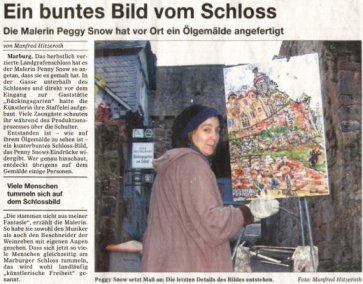
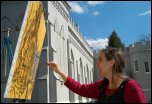 Photo by Steve Lowry.
Photo by Steve Lowry.
Belmont graduate Peggy Snow
captures the image of Community Baptist Church
before it is destroyed.
Famed painter of historic buildings in
distress, Peggy Snow, has set her easel up in front of
the Community Baptist Church in the Waverly Place area.
She hopes to put the character of the building on canvas
before it is dismantled brick by brick.
Snow has
said her passion is painting buildings “with old souls.”
The Community Baptist Church should be an appropriate
muse. One of the few remaining structures of Hugh
Cathcart Thompson, the architect of the Ryman
Auditorium, the church’s sanctuary was built in the late
1800s. The surrounding structure is being torn down to
be replaced with town homes. The sanctuary’s façade will
remain intact but the interior will become four
three-level town homes.
“It’s such an American
Gothic beauty and it’s in such good shape,” Snow
said.
Snow said there should be money set aside
for situations such as the one that befell the
church.
“I think there should be government money
allocated to help keep up our beautiful architecture,”
she said. “It’s beyond the congregation and it’s beyond
the neighborhood. All of us have a stake in
it.”
To date, Snow has painted the former train
shed next to the Union Station hotel in three stages and
the former Jacksonian apartment building twice as well
as other landmark architecture. She also paints old
barns and sheds, any building that has seen better days
but has still lived to tell about it.
Her first
painting of the train shed, done in 1991, sits in the
Tennessee State Museum. Cal Turner III bought her second
rendering of it in 1996 for $2,500.
Snow said
the sketched composition of the church is complete and
the actual painting is in the early stages, which will
be a challenge because part of the church has already
been torn down.
“The one end of it is down, the
newer end of it, about two or three layers of this solid
beautifully, three-layers-thick, hand laid brick,” Snow
said.
Snow, a graduate of Belmont University,
has had her work exhibited at the Frist Learning Center,
Cheekwood and other galleries in the city.
She
said she likes the immediacy of painting on deadline and
working on location in the fresh air with the subject
squarely in front of her. She never abandons her easel
so she must carefully prepare beforehand. She can remain
in one spot for five or six hours at a time.
“I
know there aren’t any simple answers but still it’s a
problem,” Snow said. She added she is considering
putting a book together when she has compiled enough
paintings of Nashville’s lost
architecture.
Waverly Place Neighborhood
Association president Jimmy Miller said he is delighted
the church is being memorialized.
“I think the
fact that she's chosen to paint it speaks volumes about
how Nashville's community of neighborhoods have all
rallied around that church,” Miller said. “Even more
compelling is the scrapbook of memoirs she has that
contains pages and pages of notes from those who still
support saving the church as it is.”